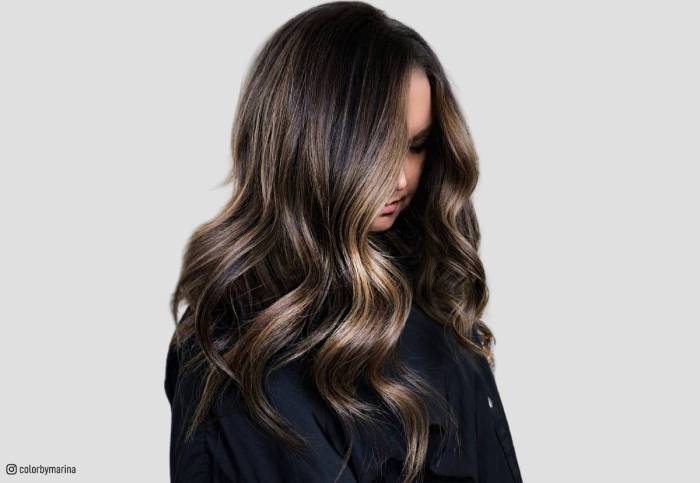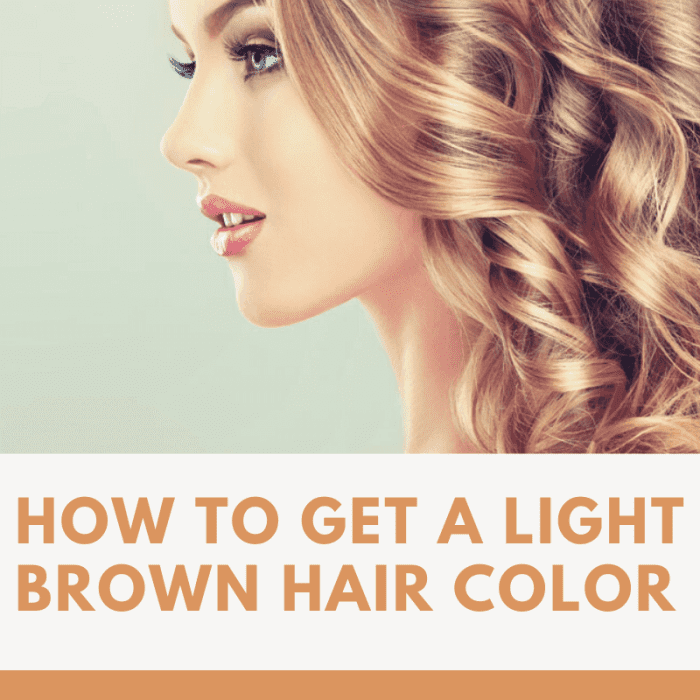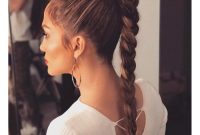From warm chocolate hues to deep espresso tones, dark brown hair color exudes an aura of sophistication and timeless elegance. Whether you’re seeking a subtle change or a dramatic transformation, achieving the perfect dark brown hair color requires careful preparation, technique, and aftercare.
In this comprehensive guide, we’ll delve into the intricacies of dark brown hair dyeing, exploring everything from selecting the right dye to maintaining your vibrant new shade.
Before embarking on your dark brown hair journey, it’s crucial to understand your current hair color and condition. This will help you determine the best course of action and avoid any potential mishaps. Additionally, gathering the necessary supplies, such as dark brown hair dye, developer, gloves, mixing bowl, and application brush, is essential for a successful dyeing experience.
Preparation and Supplies
Prior to dyeing your hair, it’s crucial to evaluate its current color and condition. This will aid in determining the appropriate hair dye and application technique to achieve your desired dark brown hair color. Factors to consider include your natural hair color, any previous hair treatments or coloring, and the overall health of your hair.
To ensure a successful hair dyeing process, gather the necessary supplies:
Dark Brown Hair Dye
- Select a high-quality dark brown hair dye that matches your desired shade. Consider your natural hair color and the level of darkness you wish to achieve.
- Opt for a permanent hair dye if you want long-lasting results. Semi-permanent or temporary hair dyes may be suitable for a more subtle change or to experiment with different shades.
Developer
- Choose a developer that is compatible with the hair dye you have selected. The developer’s volume, typically ranging from 10 to 40, determines the strength of the lightening effect.
- For dark hair, a higher volume developer may be necessary to lift the color and allow the dark brown dye to take hold effectively.
Gloves
- Wear protective gloves during the entire hair dyeing process to prevent skin staining and irritation.
- Choose gloves that are resistant to the chemicals in hair dye and are comfortable to wear for the duration of the application.
Mixing Bowl and Application Brush
- Use a non-metallic mixing bowl and application brush specifically designed for hair coloring.
- These tools help ensure thorough mixing of the hair dye and developer and facilitate even application to your hair.
Skin and Clothing Protection
- Apply a barrier cream or petroleum jelly around your hairline and ears to protect your skin from hair dye stains.
- Wear old clothing or a protective cape to prevent staining your clothes during the hair dyeing process.
Choosing the Right Dark Brown Hair Dye
Selecting the ideal dark brown hair dye depends on several factors, including the desired result, hair condition, and personal preferences. Understanding the types of hair dyes available and their distinctions will help you make an informed decision.
Types of Dark Brown Hair Dyes
- Permanent Hair Dyes:
- Semi-Permanent Hair Dyes:
- Temporary Hair Dyes:
These dyes contain chemicals that penetrate the hair shaft and permanently alter the pigment. They provide long-lasting results and excellent coverage of gray hair. However, they can be more damaging to hair and require professional application or careful at-home use.
These dyes deposit color on the hair’s surface without penetrating the shaft. They offer less dramatic and longer-lasting results compared to permanent dyes. Semi-permanent dyes are gentler on hair and can be used more frequently.
These dyes coat the hair’s surface and wash out after a few shampoos. They are ideal for temporary color changes or trying out a new shade before committing to a permanent dye. Temporary dyes are easy to use and cause minimal damage to hair.
Professional vs. At-Home Hair Dyes
Professional hair dyes are typically stronger and longer-lasting than at-home dyes. They are applied by trained professionals in a salon setting, ensuring precise application and minimizing the risk of damage. Professional dyes often contain higher-quality ingredients and offer a wider range of shades.
At-home hair dyes are more affordable and convenient, allowing for DIY hair coloring. However, they may not provide the same level of coverage or longevity as professional dyes. It’s essential to carefully follow the instructions and take precautions to avoid damaging your hair.
Selecting the Right Shade
Choosing the right dark brown hair dye shade depends on several factors, including skin tone, eye color, and desired result.
- Skin Tone:
- Eye Color:
- Desired Result:
For warm skin tones, consider warm brown shades with golden or reddish undertones. Cool skin tones may prefer cool brown shades with ashy or blue undertones.
Brown eyes look stunning with deep, rich brown shades. Hazel or green eyes may complement warmer brown shades with caramel or auburn undertones. Blue eyes can be enhanced by cool brown shades with ashy or violet undertones.
If you want a subtle change, opt for a shade close to your natural hair color. For a more dramatic transformation, choose a shade several shades darker or lighter than your current color.
3. Pre-Dye Hair Care and Treatment
Preparing your hair before dyeing is crucial for achieving a successful and healthy color transformation. Proper hair care and treatment can minimize damage, improve color absorption, and enhance the overall vibrancy of your new hair color.
Washing and Conditioning
Start by washing your hair with a gentle, sulfate-free shampoo to remove dirt, oil, and product buildup. Avoid using harsh shampoos or clarifying shampoos, as these can strip away natural oils and leave your hair dry and prone to damage.
After shampooing, apply a nourishing conditioner to replenish moisture and restore hair’s health. Leave the conditioner in for the recommended time specified on the product label, then rinse thoroughly.
Deep Conditioning and Hair Masks
A deep conditioning treatment or hair mask can provide intense hydration and nourishment to your hair, making it more resilient to the chemical processing involved in dyeing. Apply a deep conditioner or hair mask to clean, damp hair, and leave it in for the recommended time, usually around 20-30 minutes.
Rinse thoroughly.
Avoid Heat Styling Tools
In the days leading up to your hair dyeing appointment, avoid using heat styling tools such as blow dryers, curling irons, and flat irons. Heat can damage your hair, making it more susceptible to breakage and color fading. Allow your hair to air dry naturally or use a diffuser on a low heat setting to minimize heat damage.
Clarifying Shampoo
If you regularly use styling products or have a lot of product buildup, consider using a clarifying shampoo before dyeing your hair. Clarifying shampoos remove product buildup and excess oils, ensuring that the hair dye can penetrate evenly and provide consistent color results.
4. Dyeing Techniques and Application

Achieving a dark brown hair color requires careful preparation, proper application techniques, and attention to detail. Follow these steps to ensure an even and consistent result.
Mixing the Hair Dye and Developer
- Read the manufacturer’s instructions thoroughly before mixing the hair dye and developer.
- Wear gloves to protect your hands and skin from the chemicals.
- Mix the hair dye and developer in a non-metallic bowl according to the specified ratio.
- Stir the mixture until it forms a smooth and creamy consistency.
- Allow the mixture to sit for the recommended time before applying it to your hair.
Applying the Dark Brown Hair Dye
- Section your hair into manageable parts using clips or hair ties.
- Start applying the dye mixture to one section at a time, beginning with the roots.
- Use a color brush for precise application, ensuring that the dye covers all the hair strands evenly.
- Work your way from the roots to the ends of each section, making sure to saturate the hair completely.
- Once a section is covered, clip it up to keep it out of the way.
Processing Time
- The processing time for dark brown hair dye varies depending on the product and your desired shade.
- Follow the manufacturer’s instructions for the recommended processing time.
- Check the color periodically to monitor the progress and adjust the processing time if necessary.
- Rinse your hair thoroughly with lukewarm water once the processing time is complete.
- Use a color-safe shampoo and conditioner to maintain the vibrancy of the dark brown color.
Tips for Achieving an Even and Consistent Dark Brown Color
- Use a color brush for precise application, ensuring that the dye covers all the hair strands evenly.
- Section your hair into manageable parts to ensure that all areas are covered.
- Apply the dye mixture to the roots first and then work your way to the ends.
- Check the color periodically to monitor the progress and adjust the processing time if necessary.
- Rinse your hair thoroughly with lukewarm water once the processing time is complete.
- Use a color-safe shampoo and conditioner to maintain the vibrancy of the dark brown color.
5. Post-Dye Hair Care and Maintenance
To maintain the vibrancy and longevity of your dark brown hair color, proper post-dye hair care is crucial. This involves several essential steps to protect and nourish your hair, preventing premature fading and damage.
Rinsing the Hair Thoroughly
After the dyeing process, it’s essential to rinse your hair thoroughly with lukewarm water until the water runs clear. This step ensures that all excess dye and residue are removed, preventing any potential irritation or staining of your scalp and skin.
Using Color-Safe Shampoo and Conditioner
Invest in color-safe shampoo and conditioner specifically designed for dyed hair. These products are formulated to gently cleanse and condition your hair without stripping away the color molecules. They often contain ingredients that help preserve and enhance the vibrancy of the color, preventing premature fading.
Protecting Dyed Hair from Sun Damage
Sun exposure can cause the color pigments in your hair to fade and become dull. To protect your dark brown hair color, use a leave-in conditioner or hairspray with UV protection. When spending extended periods outdoors, consider wearing a hat or scarf to shield your hair from the sun’s harmful rays.
Minimizing Heat Styling Tools
Excessive use of heat styling tools, such as blow dryers, curling irons, and flat irons, can damage your hair and contribute to color fading. When using these tools, apply a heat protectant spray to your hair to minimize thermal damage and preserve the color’s vibrancy.
Avoiding Harsh Chemicals
Certain chemicals, such as chlorine in swimming pools and harsh detergents in shampoos, can strip away the color from your hair. To protect your dark brown hair color, avoid swimming in chlorinated pools without a swimming cap. When washing your hair, opt for sulfate-free and paraben-free shampoos and conditioners to prevent color fading.
6. Troubleshooting Common Dyeing Problems

Achieving the desired dark brown hair color may not always go smoothly. Various factors can contribute to common dyeing problems, such as uneven color, brassy tones, or color bleeding. Understanding these issues and knowing how to address them can help you achieve a successful dyeing experience.
Uneven Color
Uneven color distribution can occur due to improper application techniques or variations in hair porosity. To prevent this, ensure thorough mixing of the dye, sectioning hair into smaller parts for even application, and paying attention to areas that may be more difficult to reach, such as the roots and the back of the head.
Additionally, using a high-quality hair dye and following the instructions carefully can help achieve a more uniform color result.
Brassy Tones
Brassy tones, often appearing as unwanted orange or yellow hues, can arise from underlying pigments in the hair or improper color selection. To prevent brassiness, choose a dark brown dye with cool undertones, as warm undertones may enhance brassy tones.
Additionally, using a toner after the dyeing process can help neutralize unwanted tones and achieve a more desirable color.
Color Bleeding
Color bleeding, where the dye transfers onto other surfaces or objects, can be a frustrating issue. To minimize color bleeding, rinse the hair thoroughly after dyeing to remove excess dye. Additionally, using a color-safe shampoo and conditioner can help maintain the color and prevent fading.
Avoid using harsh shampoos or styling products that may strip the color from the hair.
Tips for Preventing Dyeing Problems
- Use high-quality hair dye and follow the instructions carefully.
- Conduct a strand test beforehand to assess the hair’s reaction to the dye and to determine the appropriate processing time.
- Section hair into smaller parts to ensure even application.
- Pay attention to areas that may be more difficult to reach, such as the roots and the back of the head.
- Rinse the hair thoroughly after dyeing to remove excess dye.
- Use a color-safe shampoo and conditioner to maintain the color and prevent fading.
- Avoid using harsh shampoos or styling products that may strip the color from the hair.
Consulting a Professional Hairstylist
If you encounter persistent dyeing problems or are unsure about the dyeing process, consulting a professional hairstylist can be beneficial. They can assess your hair’s condition, recommend suitable hair dye and techniques, and provide guidance to achieve the desired dark brown hair color.
7. Alternative Methods for Achieving Dark Brown Hair
Intro paragraphBesides commercial hair dyes, there are several natural and temporary methods for darkening hair color. These methods have been used for centuries and offer a more natural and gentle approach to hair coloring. Let’s explore some of these alternatives, their pros and cons, and how to use them safely and effectively.
Henna
Henna is a natural plant-based dye that has been used for centuries to color hair, skin, and nails. It is derived from the leaves of the henna plant (Lawsonia inermis) and produces a rich, reddish-brown hue. Pros:
- Natural and non-toxic
- Long-lasting results (up to 6 weeks)
- Adds shine and conditions hair
- Covers gray effectively
Cons:
- Can be challenging to apply evenly
- Limited color range (mostly reddish-brown tones)
- Can be drying to hair if not properly conditioned
Usage:
- Mix henna powder with water or a natural activator (such as lemon juice or yogurt) to form a paste.
- Apply the paste to clean, dry hair, starting from the roots and working towards the ends.
- Leave the paste on for several hours (typically 2-4 hours) before rinsing thoroughly.
- Condition hair after rinsing to restore moisture.
Coffee or Black Tea Rinse
Coffee and black tea are natural colorants that can temporarily darken hair. These rinses are particularly effective on light-colored hair and can add depth and richness to the color. Pros:
- Natural and affordable
- Easy to apply
- Provides temporary color and shine
- Can help to reduce brassiness in blonde hair
Cons:
- Results are not as long-lasting as with permanent dyes
- May need to be repeated regularly to maintain color
- Can be drying to hair if not properly conditioned
Usage:
- Brew a strong cup of coffee or black tea and let it cool.
- Wash hair as usual and rinse with the cooled coffee or tea.
- Leave the rinse in for 10-15 minutes before rinsing thoroughly.
- Condition hair after rinsing to restore moisture.
Comparative Table of Dark Brown Hair Dyes
Selecting the appropriate dark brown hair dye is crucial to achieve the desired results while maintaining hair health. Various types of hair dyes offer distinct features, advantages, and suitability for different hair types and conditions. The following comparative table provides a comprehensive overview to help you make an informed decision.
The table includes key information about permanent, semi-permanent, and temporary dark brown hair dyes. Each dye type is assessed based on its key features, advantages, disadvantages, and suitability for different hair types and conditions. The table is designed to be responsive and easy to read on various devices, ensuring clear and concise information.
Comparative Table
| Dye Type | Key Features | Advantages | Disadvantages | Suitability |
|---|---|---|---|---|
| Permanent Hair Dye | – Penetrates hair shaft, altering its natural pigment
|
– Offers complete coverage of gray hair
|
– Can cause hair damage due to harsh chemicals
|
– Suitable for all hair types
|
| Semi-Permanent Hair Dye | – Deposits color on hair surface, without altering natural pigment
|
– Gentle on hair, causing minimal damage
|
– Does not cover gray hair completely
|
– Suitable for all hair types
|
| Temporary Hair Dye | – Coats hair strands with color, without penetrating the hair shaft
|
– No commitment to long-term color change
|
– Does not cover gray hair
|
– Suitable for all hair types
|
Final Summary
With patience, precision, and proper care, achieving dark brown hair color is a rewarding endeavor that can transform your look and boost your confidence.
Remember to prioritize hair health throughout the process, using deep conditioning treatments and color-safe products to maintain the vibrancy and longevity of your new shade. Embrace your dark brown locks, let them reflect your unique personality, and enjoy the compliments that come your way!
FAQ Summary
Q: What are the different types of dark brown hair dyes available?
A: Dark brown hair dyes come in three main types: permanent, semi-permanent, and temporary. Permanent dyes offer long-lasting results, while semi-permanent dyes gradually fade over several washes. Temporary dyes, such as rinses and sprays, provide a quick and easy way to experiment with dark brown hair without commitment.
Q: How do I choose the right dark brown hair dye shade for my skin tone and eye color?
A: Consider your skin tone and eye color when selecting a dark brown hair dye shade. Warm skin tones often look best with warm brown shades, while cool skin tones may prefer ash or neutral brown tones. For blue or green eyes, try a cool-toned dark brown dye.
Hazel or brown eyes may look stunning with warm or neutral brown shades.
Q: How can I protect my hair from damage during the dyeing process?
A: To minimize hair damage, start with healthy, well-conditioned hair. Avoid heat styling tools and harsh chemical treatments beforehand. Use a clarifying shampoo to remove product buildup and ensure even color absorption. Deep conditioning treatments and hair masks can also help strengthen and protect your hair during the dyeing process.
Q: How long should I leave the dark brown hair dye on my hair?
A: The processing time for dark brown hair dye varies depending on the type of dye and the desired result. Always follow the manufacturer’s instructions carefully. Permanent dyes typically require longer processing times, while semi-permanent and temporary dyes may only need a few minutes.
Q: How can I maintain the vibrancy of my dark brown hair color?
A: To keep your dark brown hair color looking its best, use color-safe shampoo and conditioner designed to protect colored hair. Avoid harsh chemicals and heat styling tools whenever possible. Regular deep conditioning treatments can also help maintain hair health and prevent fading.
Additionally, consider using a color-depositing conditioner or gloss to refresh your color between dye applications.



